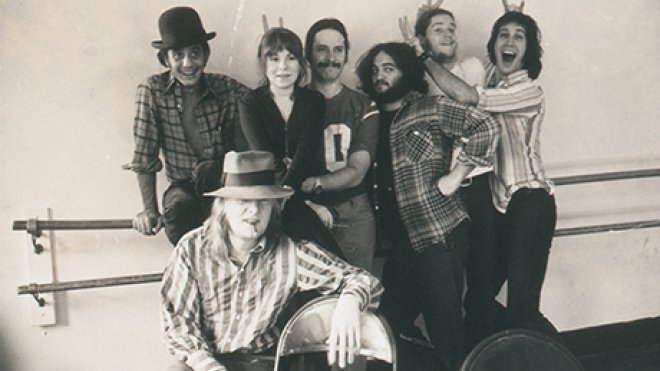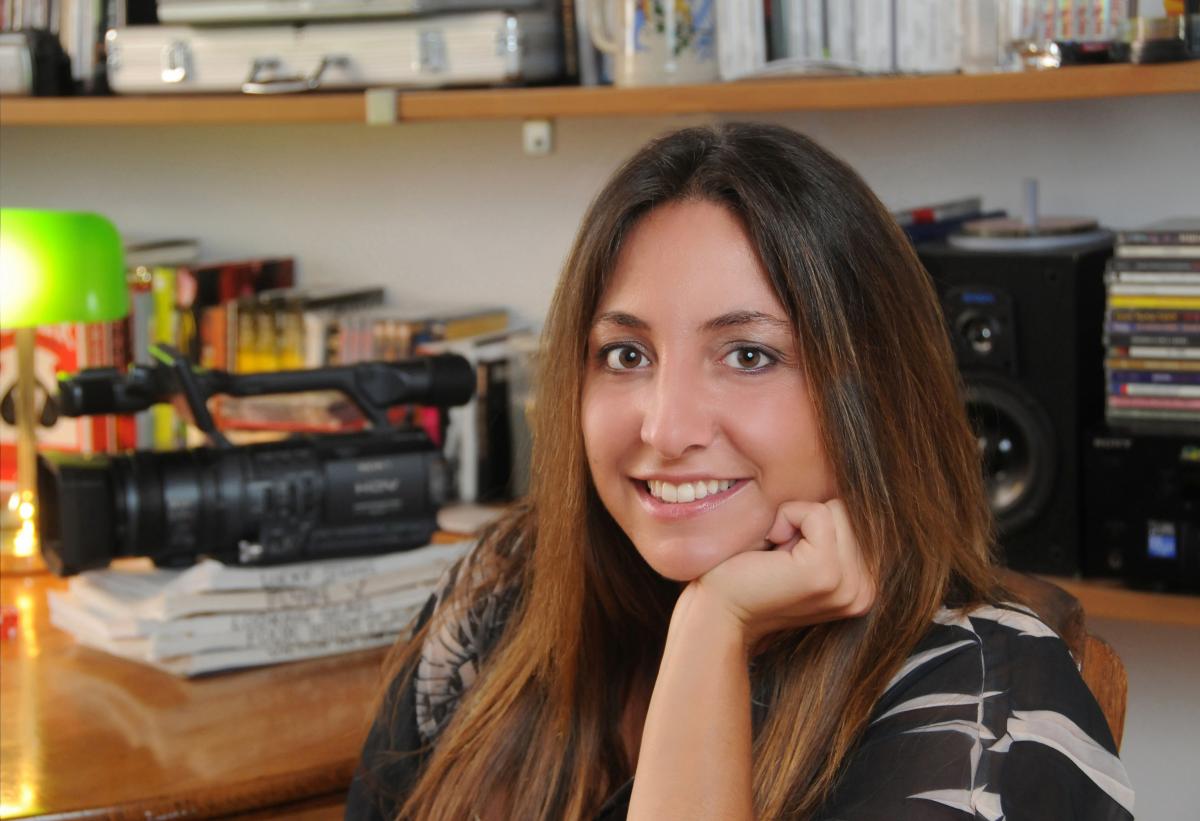Funny Business: Susan Bedusa ’01 Helms National Lampoon Documentary
The moose out front should’ve told you – go see alumna Susan Bedusa’s new film, Drunk Stoned Brilliant Dead: The Story of the National Lampoon

New York, N.Y. – Whether you’re a Vacation person or you prefer the raucous and raunchy Animal House, National Lampoon has had audiences laughing for more than 40 years. But before Hollywood (and, by proxy, Saturday Night Live) could poach top comedic talent like Chevy Chase, John Belushi, Bill Murray and Gilda Radner, The National Lampoon – a subversive and groundbreaking magazine published out of Harvard University – was paving the way for a new genre of satirical comedy that thrived on making people uncomfortable (and, in a nod to their youthful male readers, nudity).
Roger Williams University alumna Susan Bedusa ’01 delved deep into this 
comedic underground as producer of the recently released documentary, DRUNK STONED BRILLIANT DEAD: The Story of the National Lampoon. An official selection at the Sundance Film Festival, the film brings to life the magazine that set the stage for a seismic shift in the world of comedy.
As senior vice president of production and development at 4th Row Films, Bedusa has produced nine feature documentaries – including “All In: The Poker Movie” and “Hey Bartender” – as well as MTV’s hit TV series “The X-Effect.” But she has never been part of a production quite like this one, she says. Here, Bedusa shares how DRUNK STONED BRILLIANT DEAD: The Story of the National Lampoon is different than any other film she’s worked on, why the story needed to be told and how her team brought it to life.
This project seems like it was a labor of love. When was the seed planted and how did it come to see the light of day?
We’re a small production company, so we do everything from having an idea, to making the deal, to getting people to agree to be in the film, to actually filming and editing and coming up with the style. My role started a long time ago when we had nothing but an idea. After finishing our last film, I asked my partner [Douglas Tirola] if he could do a documentary on anything, what would it be? The magazine is a passion of his, and I grew up with National Lampoon’s Vacation, so I said well, let’s try! A lot of Oscar-winning producers were trying to do the film at the same time at us, but National Lampoon really liked our take on it, and we secured the rights.
How were you able to trump the high-end producers in getting the rights to the film?
Our idea was that we wanted to tell the story from the beginning, not just the golden years. Our vision was to go from the start and until Vacation, 1969 to 1983. The other real take on it was that we wanted to option the archive of the National Lampoon. We made the deal to license the entire archive. One of Doug’s creative visions was to not use stock photos or b-roll in the entire film; every single image in the film, if not photos or videos of the people talking, comes straight from the magazine. I can’t even explain how many late, late overnights we spent flipping through these magazines and finding the perfect artwork for every single thing people were saying for 90 minutes.
How many years in process was this project?
We started talking about this film at the conclusion of our poker film in 2009. In March 2010, we got the call from Matty Simmons [producer of Animal House] saying he would do it. Getting the deal together and being the people with the exclusive rights to tell the story took a long time to negotiate.
The tone of National Lampoon is irreverent and uncomfortable. Is that a feeling you replicate in the documentary, and how do you strike that tone throughout the film?
Well, the first minute of the film is a joke about incest, which really sets the tone. It is totally uncomfortable, but to me it’s really significant that people today can’t speak their mind. Everything is racist or sexist or something, and what happens because of that is that nobody talks at all. What’s important about the National Lampoon is that they will make a joke that may seem racist on the surface, but when you really look at what they’re saying, they’re making fun of the racist, the ignorant people. I think that it’s important to use comedy to open up conversations. People are afraid to speak, and that’s an awful thing that came out of us trying to be too politically correct.
Since making the film, why do you think something that was so underground and completely cultish was able to infiltrate mainstream pop culture?
There was just an extremely high level of talent. The writers wrote in a way that was super highbrow and intellectual – from Harvard, they were some of the smartest people in the country – but were also able to write to relate to the normal kid, the teenager. There was nothing like the National Lampoon before, and people were hungry for it; it was stuff young people were seeking out. The magazine brought people together, and readers felt a part of something.
Any revelatory moments on set?
We joke that everyone is either an Animal House person, or a Vacation person – I’m a Vacation person. I didn’t know the magazine that well, because I wasn’t born when they were popular, but Chevy Chase was my hero. When we went to interview, we did Chevy Chase and Beverly D’Angelo in the same day, and I kept saying I felt like I was going to see my parents! It was that much a part of my childhood. However, once Doug wanted to make this movie, he brought me a stack of magazines, and I realized how insane and great it was. Immediately, I said, “I get it.” It’s a treasure.
What was it like to premiere one of your films at the Sundance Film Festival?
It was insane. Having done a film was not unusual for me, but I had never premiered one of my own films at Sundance before. It was awesome and nerve wracking, but we got a great response from the audience – they loved it. I just remember going back to my hotel room afterward and sitting in the dark for an hour. My adrenaline was way too high for way too long. I would absolutely love to do it again.
We’ve seen success with the new National Lampoon film and the spin-off Van Wilder series, but how else has the National Lampoon influenced comedies coming out now?
The thing that made National Lampoon so successful during the era that we told was the talent of the people creating the content, and then they took those short stories from the magazines and made movies out of them., There was a good chunk of time after Van Wilder and beyond that some owners didn’t respect the brand, which is when it began to go south. Now, there is a new CEO and they are really committed to getting back to the old way of doing things. They have this amazing archive where they can take these amazing works and create movies and other content from. They’re going to be looking for real, talented writers, which I think will make them successful again.
How did working on this film compare to your previous films?
We do a lot of different types of films. One was about poker, one was about bartending, one was about prison, and then we do other films that are more artistic and intimate and smaller. This film was different because we ended up partnering with A&E History Films, so we were working with a few executive producers and a writer. This was interesting because we had partners and we had money and a bunch of things that we were not used to having, although all our films use the same muscles. The executive producers had really encouraging outside voices, and Doug and I listened to them in a different way than we listened to each other. In the past, we just did the films ourselves.
Pardon the pun, but what’s on tap?
We have a few things lined up; we’re doing one film about a heavy-metal musician who fell on some hard times and is trying to reinvent himself as a classical composer, and another film about the world of toys. We’re in the deal-making process of two other, bigger films, but I can’t say any more than that!
Click here for more on the film, including screenings and On Demand information.